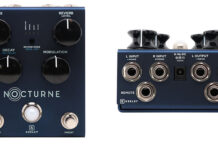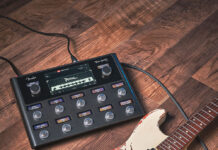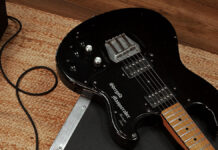![image-placeholder-titl[44]](https://www.promusic.news/wp-content/uploads/2018/07/image-placeholder-titl[44]-300x100.jpg)
Meet the "Hammer-On from Nowhere"
Of the infinite number of cool things about the guitar, among the coolest are the many means of articulation possible for producing and expressing notes.
More often than not, notes are picked, plucked, slapped, popped, tapped, slid in to, pulled off to or hammered-on to from another note. But there is another oft-overlooked technique that can add slippery finesse, intervallic interest and muscular, musically arousing power to your playing: the “hammer-on from nowhere.”
The technique is simple. Instead of picking a string to play a note when crossing to a new string, the fret hand produces the note on the new string by hammering it down. Like pick hand tapping, but with the fret hand creating the note with an unused finger, the “hammer-on from nowhere” technique allows for a unique, smooth efficiency.
EXAMPLE 1 is the basic technique as popularized by Eddie Van Halen. Based on the Am pentatonic (A, C, D, E, G) box fingering for the fretting hand and a simple single fret (12th) for the tapping hand, the line moves in a smooth descending pattern facilitated by the hammer-on from nowhere. After the initial right-hand tap and the successive notes on the E string, the pattern continues on the B string with the fret-hand ring or pinky finger hammering down the next note in the pattern before the phrase continues with a tap on the same string. Note the rhythmic offset of the groupings, which also aids in the flow of the line.
Though the bulk of the examples I’ll be going over will involve tapping, it’s important to look at an example of a line executed exclusively with the fret hand.
Based in E Phrygian Dominant (E, F, G#, A, B, C, D—the 5th mode of A harmonic minor) and alternating between 1-3-4 and 1-2-4 fingerings, EXAMPLE 2 is a pattern similar to those utilized by Allan Holdsworth, Steve Vai and Joe Satriani, in this case flowing one string at a time, descending across all six strings. Use a strong, firm hammer with the pinky to execute the “hammer-on from nowhere.” Be sure to experiment with different phrasing patterns and string crossings.

Shifting gears and taking the concept in another direction, EXAMPLE 3 is a B Locrian (B, C, D, E, F, G, A) theme using moving hammered 5ths with the fret hand. Get into the hypnotic quality of the lick and focus on rhythmic synchronization.

EXAMPLE 4 expands on the basic idea of the previous example, this time honing in on the relationship between the tapped and open B notes and the tritone (F), but has the “hammered from nowhere” note alternating from the string higher than the “main” phrase to the string below it. This opens up the intervallic movement within the lick considerably. Try this with bigger jumps between strings and with bigger stretches for some surprising results!

And just when you thought you’ve seen enough ways to execute arpeggios, EXAMPLE 5 is a fresh take that once again opens up the intervallic space between the Am (A,C,E) chord tones with two separate hammers from nowhere. The substitution of G# in the latter half of beat 4 implies a chord change to E and gives the line an “alien carnival” vibe. Loop it slow or fast for equally cool results and use either the fret hand index or middle finger for maximum efficiency executing the aforementioned G#.

Finally, for some symmetrical fun, EXAMPLE 6 is a companion loop lick to the Am lick above, this time with an index finger hammer followed by a pinky hammer with each string change. This can be tricky and challenging at first, but if you get the basic pattern down and use sufficient force, you’ll be burning through it in no time. As with all of the above examples, be sure to focus on a strong physical rhythmic coordination between both hands.

Try to avoid using excessive processing such as compression or too much distortion in an attempt to make the notes “pop.” Instead, practice strong, firm, confident, forceful articulation unassisted by anything other than your hands and your guitar. Also, be sure to mute all unused strings with both hands.
There’s no hair ties or socks tied around the neck necessary to keep string noise to a minimum with these licks, just careful attentiveness as you develop the instinctual control over the technique (and they use too many open strings anyway). The applications of this basic technique vary greatly, so get it under your fingers, listen to how some of your favorite players utilize it and experiment! Happy shredding!
Scott Marano has dedicated his life to the study of the guitar, honing his chops at the Berklee College of Music under the tutelage of Jon Finn and Joe Stump and working as an accomplished guitarist, performer, songwriter and in-demand instructor. In 2007, Scott developed the Guitar Strength program to inspire and provide accelerated education to guitarists of all ages and in all styles through state-of-the-art private guitar lessons in his home state of Rhode Island and globally via Skype. Visit Scott and learn more at GuitarStrength.com.
Photo: Kevin Winter/Getty Images
Source: www.guitarworld.com










